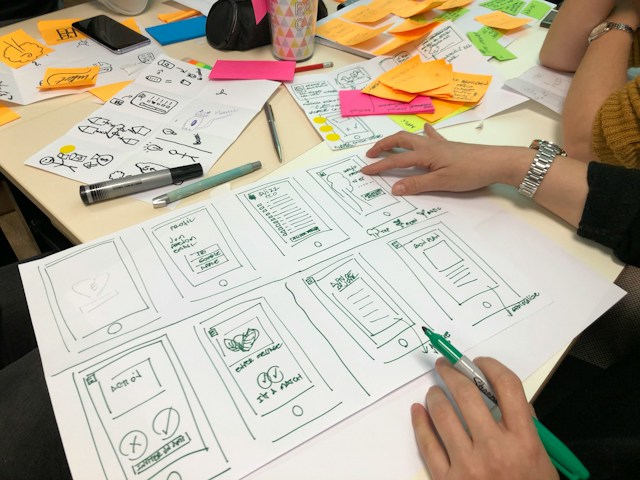It’s no secret that the UX design process aims to enhance every step of the user’s journey. Since Donald Norman invented the term ‘UX design’ in 1995, UX designers have developed methods to optimize the user experience.
Nearly thirty years later, it’s safe to say that the modern digital landscape has an abundance of great UX websites.
However, in order to create the highest standard to hold your own UX designs to, great UX won’t cut it. To truly flourish as a UX designer, you must encounter and evaluate the best UX websites.
Within today’s actionable guide, we’ll look at examples of the best UX websites. We’ll also address the universal qualities that all of the best UX websites share. By the time you’ve finished reading this article, you’ll know how to create an exceptional user experience for all users.
What Is UX Design?
If you’re new to UX design, it’s only logical to address the meaning of UX design before we examine examples. If you’ve found yourself wondering, ‘What is UX Design?’, you’ve come to the right place!
UX design is a vital facet of digital product development. Specifically, UX design focuses on the interactions and experiences that users have with a company’s/brand’s product.
A UX designer aims to unify design elements like usability, accessibility, navigability, and content to create the perfect user experience.
In order to achieve their goals effectively, a UX designer will collaborate with other professionals in the UX field. UX researchers will acquire user-focused data to reveal their target users’ needs, desires, mental models, and pain points. This data will serve as the foundation of the UX designer’s work.
Additionally, UX designers will also work with user interface designers (UI designers). UI designers will add visually appealing and functional elements to the UX designer’s blueprint.
As you can see, UX design is a huge collaborative effort that demands nothing less than the utmost dedication. For UX designers, unparalleled dedication appears in the form of must-have qualities within their products and websites.
It’s time for you to familiarize yourself with those qualities.

Universal Qualities of the Best UX Websites
No two products are the same when it comes to UX design. Even with similar products, the user research acquired to refine the product will show fluctuations in data. Commonly, this is a consequence of different research methods used, sample sizes, or target audiences.
Don’t worry—this is a good thing. Although we don’t recommend that you reinvent the wheel with your designs, exhibiting uniqueness will make your product stand out.
Before you imbue your products with your creative flair, however, you must ensure they demonstrate the basic, universally effective qualities.
Here are the qualities that every digital product should display:
- An effective digital product will demonstrate user-centricity.
- An effective digital product will demonstrate usability and functionality.
- An effective digital product will demonstrate accessibility.
- An effective digital product will meet SEO requirements.
- An effective digital product will display dynamic features and content.
- An effective digital product will demonstrate fluid navigability.
- An effective digital product will have a good page load speed.
- An effective digital product will demonstrate responsivity.
- An effective digital product will exhibit visually intriguing designs.
- An effective digital product will follow security protocols.

UX: Best Practices For Websites
Knowing the qualities of the best UX websites is one thing. However, in order to go the extra mile for your users, you’ll need a few more tips and tricks.
Peruse the list below and make a note of the best practices for UX websites.
1. User-Centricity
A user-centric design involves more than just intriguing aesthetics. User-centricity unifies straightforward navigation, relevant content, a de-cluttered user interface, and understandable visual hierarchies. The primary goal of user-centricity is to satisfy the user’s needs.
Here’s how to ensure you create user-centric designs.
You start by asking the right questions about your target audience. Ask yourself:
- Who are my users?
- What are my users’ end goals?
- When will your users utilize your products?
- Will your users already be familiar with your products/services?
- What pain points are my users experiencing with similar products?
In asking these questions, you’ve defined your research goals and can start collecting qualitative and quantitative data.
Once you’ve collected valuable data, you can conduct user testing to identify correlations between your assumptions and actual user behaviors.

2. Simplicity
As an aspiring creative UX designer, you may wonder why the best UX websites utilize simplistic visuals and structures.
Simplicity, within UX, means that your product won’t demand a steep learning curve from your users. Additionally, simplicity is synonymous with familiarity. In employing simplistic designs, you allow the user to rely heavily on their intuition to use and navigate your product.
Here’s how you can create simplistic UX designs.
- Select a typography that is easy to read.
- Choose a color scheme that is easily viewable.
- Don’t use too many colors in your color scheme.
- Always make sure your text color contrasts with the background.
- Only use graphics if they help the user accomplish their goals.
3. Navigability
Your users will abandon your product if they struggle to find their desired content easily/quickly. This is why the navigational ease of your product is so crucial to the user’s experience.
Here’s how you can ensure that your designs exhibit utmost navigability.
- Utilize clear content categories and simple, descriptive labels.
- Use conventional menu items like ‘About Us’ or ‘Contact Us.’
- Implement a search bar.
- Implement a navigation footer.
- Employ ‘breadcrumbs.’
- Utilize a straightforward visual hierarchy.
4. Responsitivity
To go the extra mile for your users, you must make sure your product is compatible with multiple electronic devices.
With a responsive product, your automatically reorganized content suits any and all of the users’ devices.
Here’s how you can ensure that you’ve created a responsive design.
- Use mobile-friendly HTML templates.
- Implement responsive images and typography.
- Set appropriate responsive breakpoints.
- Test your product’s cross-browser compatibility.

5. Consistency
Consistent UX designs are integral to a digital product’s success. With consistency, your users will have a seamless user experience, relying on their expectations to interact with the product.
Consistency also helps you adhere to your company or brand’s specifications. When you consistently represent your brand, you’ll increase brand recognition and bolster the expansion of your user base.
Here’s how to ensure you’ve created consistent designs.
- Utilize the same branding themes and color schemes.
- Employ consistent UI elements like icons, images, and videos.
- Use a consistent tone when creating content and marketing copy.
- Stick to conventional user flows and design patterns.
The Best UX Websites: Valuable Examples
Now that you know what to look for in your own UX designs, it’s time to evaluate other designers’ work.
We’ve carefully selected several examples of digital products/websites that exhibit spectacular UX designs. Additionally, we’ll analyze what makes our examples stand out.
In following our analysis, you’ll find it easier to conduct your own evaluation of similar products to your own. From there, you’ll identify areas of improvement in their products, which will influence the design of yours.
1. Calm
Calm is an app that helps with meditation and sleep.
Immediately, you can tell that Calm’s product demonstrates strong empathetic research efforts.
On Calm’s landing page, the first thing the user experiences is a relaxing image of a mountainous landscape. Just below this image, you can see a video of relaxed users and a brief introductory message from Calm. The UI for both the app and the website displays soothing colors that would help the user complete their goals.
The navigational ease of Calm’s website is also incredibly useful to new users. Consider Calm’s content categories. With little more than a brief summary and light-colored icons, the user knows what to expect from each service.

2. ASOS
ASOS provides a straightforward online shopping experience that allows the user to order fashionable clothing items.
Specifically, we’ll look at ASOS’s landing page. The majority of the landing page’s space displays two images that demonstrate their fashion-related expertise.
Without demanding that users read large amounts of copy, ASOS has conveyed its products’ most intriguing elements. To further this concept, ASOS has perfectly placed its CTAs – in the center of the page.
By drawing the users’ attention immediately to the CTAs with captivating color contrasts, the user’s navigational ease is straightforward.
Below the conventional placement of the search bar, colors and proportions emphasize a promotional discount announcement.
This incentivizes the users to peruse the site longer, which increases the likelihood of garnering user loyalty.

3. Keurig
Keurig provides beverage brewing systems for home and commercial use.
Initially, what you see when you browse their website is an adherence to the brand’s identity. Keurig creates products that exhibit flawless aesthetics and usability. Thus, when perusing their website, you’ll witness visually appealing color schemes and designs, as well as an easy-to-follow visual hierarchy.
Given the complex design of the product, it’s natural to expect that Keurig must utilize an array of technical jargon. Seemingly, this would go against the principle of simplicity. However, Keurig has broken up its product’s most compelling features into easily understandable, intuitive sections.
Using conventional icons, the user can easily understand what they will buy and what they should expect from the product.

The Best UX Portfolio Websites
Now you know the best qualities and practices of first-rate UX design websites. You’ve also seen high-quality examples of exceptional UX designs in action.
It’s time for the next step. A UX designer who consistently creates user-centric designs requires a platform to share said designs. To improve as a designer, you must do two things: create a portfolio and garner feedback relating to your portfolio.
So, with that in mind, peruse our list of the best UX portfolio websites and start sharing your work!
UX Design: Creating Websites That Meet (and Exceed) the User’s Expectations
The key takeaway from this article is that all of the best UX websites stem from one overarching principle: user-centricity.
Without having a solid understanding of your users on a psychological and sociological level, you can’t satisfy their needs. And, of course, if your product doesn’t satisfy the users’ needs, you know it’s time to restart the design process.
With the right inspiration, you won’t have to worry about missing the mark with your users. We’ve provided you with the necessary knowledge to thrive within the UX field, but why should we stop there? Consider your latest source of spectacular UX inspiration—Page Flows.
With over 4,200 recordings of tried and tested products, our user flows demonstrate our keen eye for simple fluidity.
We’ll provide you with a knowledge base that’ll guide you as you see how successful products optimize the user’s experience! Inspired by the best UX websites, we’ve garnered a satisfied, loyal user base of over 1,000 happy customers.
From ASOS to Amazon, we offer an abundance of user flow inspiration!
Get started today to access our growing library of user flow recordings and finally stay up-to-date with current design trends.




